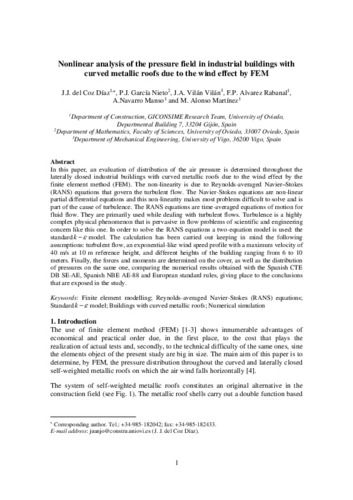Nonlinear analysis of the pressure field in industrial buildings with curved metallic roofs due to the wind effect by FEM
Palabra(s) clave:
Finite element modelling
Reynolds-averaged Navier-Stokes (RANS) equations
Standard k-e model
Building with curved metallic roofs
Numerical simulation
Fecha de publicación:
Editorial:
Elsevier
Versión del editor:
Citación:
Descripción física:
Resumen:
In this paper, an evaluation of distribution of the air pressure is determined throughout the laterally closed industrial buildings with curved metallic roofs due to the wind effect by the finite element method (FEM). The non-linearity is due to Reynolds-averaged Navier–Stokes (RANS) equations that govern the turbulent flow. The Navier-Stokes equations are non-linear partial differential equations and this non-linearity makes most problems difficult to solve and is part of the cause of turbulence. The RANS equations are time-averaged equations of motion for fluid flow. They are primarily used while dealing with turbulent flows. Turbulence is a highly complex physical phenomenon that is pervasive in flow problems of scientific and engineering concern like this one. In order to solve the RANS equations a two-equation model is used: the standard model. The calculation has been carried out keeping in mind the following assumptions: turbulent flow, an exponential-like wind speed profile with a maximum velocity of 40 m/s at 10 m reference height, and different heights of the building ranging from 6 to 10 meters. Finally, the forces and moments are determined on the cover, as well as the distribution of pressures on the same one, comparing the numerical results obtained with the Spanish CTE DB SE-AE, Spanish NBE AE-88 and European standard rules, giving place to the conclusions that are exposed in the study
In this paper, an evaluation of distribution of the air pressure is determined throughout the laterally closed industrial buildings with curved metallic roofs due to the wind effect by the finite element method (FEM). The non-linearity is due to Reynolds-averaged Navier–Stokes (RANS) equations that govern the turbulent flow. The Navier-Stokes equations are non-linear partial differential equations and this non-linearity makes most problems difficult to solve and is part of the cause of turbulence. The RANS equations are time-averaged equations of motion for fluid flow. They are primarily used while dealing with turbulent flows. Turbulence is a highly complex physical phenomenon that is pervasive in flow problems of scientific and engineering concern like this one. In order to solve the RANS equations a two-equation model is used: the standard model. The calculation has been carried out keeping in mind the following assumptions: turbulent flow, an exponential-like wind speed profile with a maximum velocity of 40 m/s at 10 m reference height, and different heights of the building ranging from 6 to 10 meters. Finally, the forces and moments are determined on the cover, as well as the distribution of pressures on the same one, comparing the numerical results obtained with the Spanish CTE DB SE-AE, Spanish NBE AE-88 and European standard rules, giving place to the conclusions that are exposed in the study
ISSN:
Identificador local:
20131167
Patrocinado por:
The authors express deep gratitude to the GICONSIME Research Group at Oviedo University for their useful assistance as well as the student Rubén Bermejo Garcia for his valuable collaboration.This work was partially financed by the Gijon City Council through the SV-13-GIJON-1.7 project, and the Spanish Ministry of Science & Innovation and the Asturias Government cofinanced with FEDER funds under the Research Projects BIA2012-31609 and FICYT-PC-10-33, respectively. Besides we would also like to thank Swanson Analysis Inc. for the use of ANSYS University program and Workbench simulation environment
Colecciones
- Artículos [37556]
- Construcción e Ingeniería de Fabricación [508]
- Investigaciones y Documentos OpenAIRE [8424]
Ficheros en el ítem





